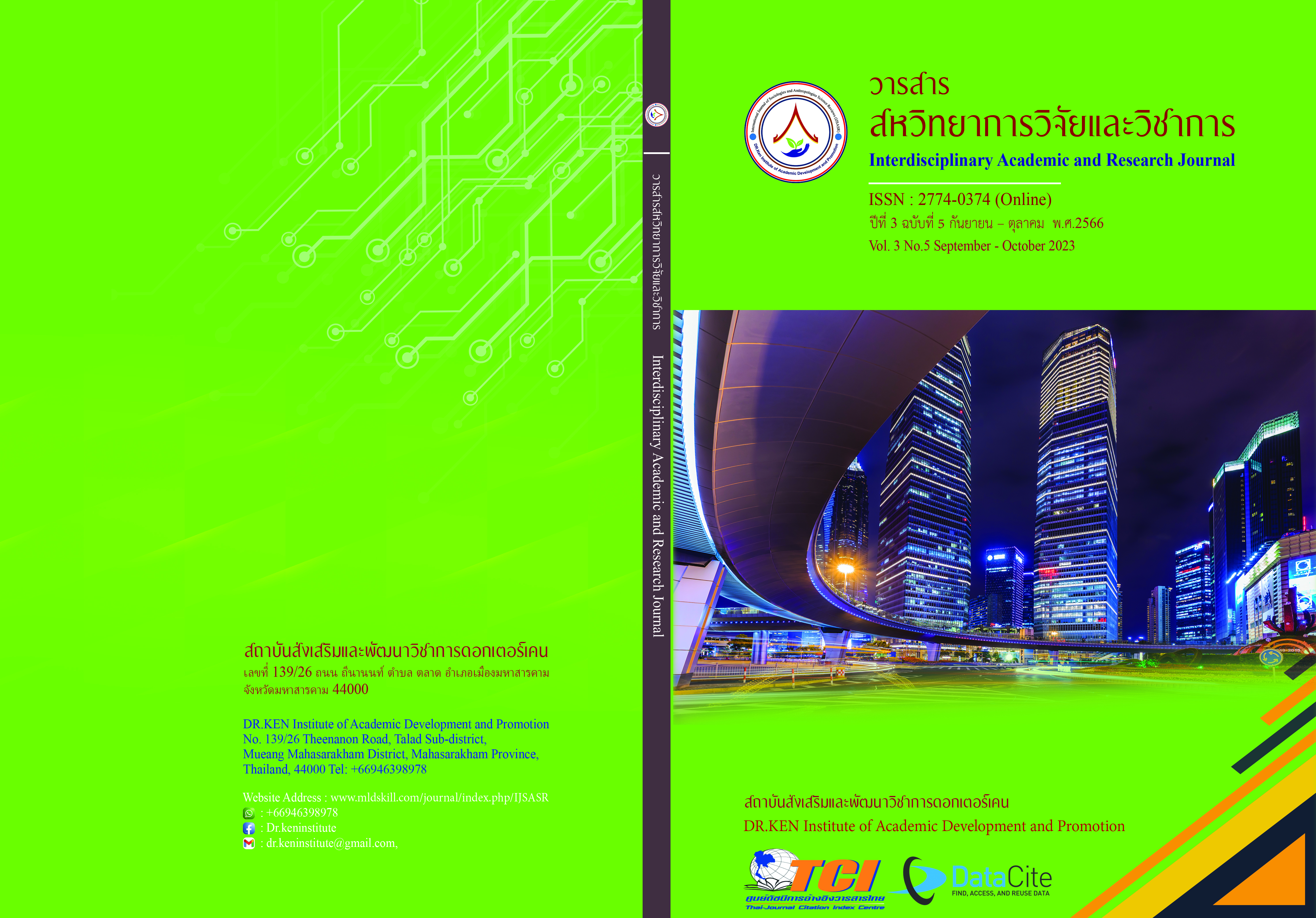The Study of Mathematical Literacy of Eighth-Grade Students by Using Mathematics Learning Activities Focusing on Open Approach
DOI:
https://doi.org/10.14456/iarj.2023.252Keywords:
Open Approach; , Mathematical Literacy; , Mathematics Learning ActivitiesAbstract
Mathematical literacy is one of the most important abilities to live in the 21st century. But according to PISA results, the mathematical literacy of Thai students is still lower than the OECD average which implies that mathematics learning management can’t encourage students to learn mathematics with meaning. Therefore, the purpose of this research was to study the mathematical literacy of eighth-grade students by using mathematics learning activities focusing on an open approach. The target group was 44 eighth-grade students. The research instruments were mathematics lesson plans on an open approach and mathematical literacy tests. The researcher analyzed data by using basic statistics which were mode and percentage and analyzed qualitative data using content analysis. Then present the data in the form of analytic descriptions, based on students’ behavior or concepts of problem-solving that represent students’ mathematical literacy. The research findings revealed that 34.09% of the students obtained mathematical literacy scores at a good level and 31.82% at an excellent level from all students. For the problems that the students face in real life, students used mathematical problem-solving processes that demonstrated contiguous mathematical literacy. For example, most students could use various types of polygons to represent a map of Pathumtani to assemble to be close to the given map to calculate the area with the least discrepancy. The students could apply knowledge about the formula for finding the area of polygons to accurately find the approximate area of Pathum Thani Province, while a minority of students could revise the procedures for finding the area with less discrepancy represented by other types of polygons.
References
เกวลี มาหา. (2565). ผลการจัดการเรียนรู้โดยใช้วิธีการแบบเปิด (Open Approach) ร่วมกับกระบวนการแก้ปัญหาเชิงสร้างสรรค์ที่มีผลต่อความสามารถในการแก้โจทย์ปัญหาและความคิดสร้างสรรค์ทางคณิตศาสตร์ของนักเรียนชั้นมัธยมศึกษาปีที่ 4. วิทยานิพนธ์ศิลปศาสตรมหาบัณฑิต สาขาวิชาการสอนวิทยาศาสตร์และคณิตศาสตร์, มหาวิทยาลัยมหาสารคาม.
เจนสมุทร แสงพันธ์ และน้ำผึ้ง อินทะเนตร. (2560). การประเมินสภาวะความเป็นปัญหาของนักเรียนในการแก้ปัญหาทางคณิตศาสตร์ ในชั้นเรียนที่ใช้การศึกษาชั้นเรียนและวิธีการแบบ. The 22nd Annual Meeting in Mathematics (AMM 2017) Department of Mathematics, Faculty of Science Chiang Mai University, Chiang Mai, Thailand (AMM 2017). 22, 1-15.
ชัยยศ จระเทศ. (2558). การส่งเสริมความสามารถในการคิดแก้ปัญหาด้วยการจัดการเรียนรู้แบบผสมผสานโดยใช้ปัญหาเป็นฐาน ห้องเรียนพิเศษวิทยาศาสตร์ สำหรับนักเรียนชั้นมัธยมศึกษาปีที่ 5 โรงเรียนวาปีปทุม. วิทยานิพนธ์ครุศาสตรมหาบัณฑิต สาขาวิชาคอมพิวเตอร์ศึกษา, มหาวิทยาลัยราชภัฏมหาสารคาม.
นภาพร วรเนตรสุดาทิพย์. (2563). การศึกษาชั้นเรียน (Lesson Study) และวิธีแบบเปิด (Open Approach), กรณีศึกษาโรงเรียนสาธิตมหาวิทยาลัยขอนแก่น (ศึกษาศาสตร์) ระดับประถม. Journal of EducationKhon Kaen University. 32 (4), 76-80.
นิรัญชลา ทับพุ่ม และ วนินทร พูนไพบูลย์พิพัฒน์. (2564). การส่งเสริมทักษะการอภิปรายโต้แย้งทางคณิตศาสตร์ด้วยกิจกรรมการเรียนรู้ด้วยวิธีการแบบเปิด เรื่องความคล้ายของนักเรียน ชั้นมัธยมศึกษาปีที่ 3. Journal of Arts Management. 5 (3), 1-83.
ประภัสสร เพรชสุ่ม. (2560). ผลการจัดกิจกรรมการเรียนรู้โดยใช้วิธีการแบบเปิดที่มีต่อความสามารถในการแก้ปัญหาทางคณิตศาสตร์ ของนักเรียนชั้นมัธยมศึกษาปีที่ 2. วารสารราชพฤกษ์. 15 (1), 80-87.
รุ่งทิวา บุญมาโดน. (2560). การวิจัยปฏิบัติการเพื่อพัฒนาการรู้เรื่องคณิตศาสตร์ เรื่อง ความน่าจะเป็นของนักเรียนชั้นมัธยมศึกษาปีที่ 5 ด้วยการจัดการเรียนรู้โดยใช้บริบทเป็นฐาน. วิทยานิพนธ์การศึกษามหาบัณฑิต สาขาวิชาคณิตศาสตร์, มหาวิทยาลัยนเรศวร.
สถาบันส่งเสริมการสอนวิทยาศาสตร์และเทคโนโลยี (สสวท.). (2555). ทักษะและกระบวนการทางคณิตศาสตร์. พิมพ์ครั้งที่ 3. กรุงเทพมหานคร: โรงพิมพ์ คุรุสภา.
สถาบันส่งเสริมการสอนวิทยาศาสตร์และเทคโนโลยี (สสวท.). (2564). ผลการประเมิน PISA 2018 การอ่านคณิตศาสตร์ และวิทยาศาสตร์. กรุงเทพมหานคร: สถาบันส่งเสริมการสอนวิทยาศาสตร์และคณิตศาสตร์.
สถาบันส่งเสริมการสอนวิทยาศาสตร์และเทคโนโลยี (สสวท.). 2563. PISA กับการประเมินความฉลาดรู้ด้านคณิตศาสตร์. FOCUS ประเด็นจาก PISA. (10 มิถุนายน 2563), 1.
สุลัดดา ลอยฟ้า และ ไมตรี อินทร์ประสิทธิ์. (2547). การพัฒนาวิชาชีพครูแนวใหม่เพื่อส่งเสริมการเรียนรู้คณิตศาสตร์. KKU JOURNAL OF MATHEMATICS EDUCATION. 1 (1), 18-28.
Becker, J.P., & Shimada, S. (1997). The Open-Ended Approach: A New Proposal for Teaching Mathematics. Reston, Virginia: National Council of Teachers of Mathematics.
Inprasitha, M. (2010). One feature of adaptive lesson study in Thailand –Designing learning units. Proceedings of the 45th Korean National Meeting of Mathematics Education. Dongkook University: Gyeongju, 193-206.
Jamil, A., & Khusna, A. (2020). A Worksheet Characterized by Open-Ended Approach to Support Student’s Mathematical Literacy. Mathematics Education Department, University of Muhammadiyah Malang.
Nohda, N. (2000). Teaching by Open-Approach Method in Japanese Mathematics Classroom. In Nakahara, T., Koyama, M. (eds.) Proceedings of the Conference of the International Group for the Psychology of Mathematics Education (PME). 24 (1), 39–53.
OECD. (2018). PISA 2022 MATHEMATICS FRAMEWORK (DRAFT). Retrieved October 20, 2022, from: https://pisa2022-maths.oecd.org/files/PISA%202022%20Mathematics%20Framework%20Draft.pdf.
Polya, G. (1957). How to solve it. Princeton, NJ: Princeton University.
Shimizu, Y. (1999). Aspects of mathematics teacher education in Japan: Focusing on teachers’ roles. Journal of Mathematics Teacher Education. 2 (1), 107-116.
Smith, M. S., & Stein, M. K. (2011). 5 practices for orchestrating productive mathematics discussions. Reston, VA: National Council of Teachers of Mathematics.
Downloads
Published
How to Cite
Issue
Section
License
Copyright (c) 2023 Pisitta Kachai, Songchai Ugsonkid, Chanon Chuntra, Sakon Tangkawsakul

This work is licensed under a Creative Commons Attribution-NonCommercial-NoDerivatives 4.0 International License.
Copyright on any article in the Interdisciplinary Academic and Research Journal is retained by the author(s) under the under the Creative Commons Attribution-NonCommercial-NoDerivatives 4.0 International License. Permission to use text, content, images, etc. of publication. Any user to read, download, copy, distribute, print, search, or link to the full texts of articles, crawl them for indexing, pass them as data to software, or use them for any other lawful purpose. But do not use it for commercial use or with the intent to benefit any business.
















.png)


